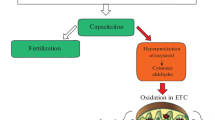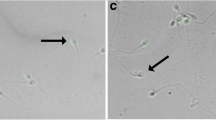Abstract
Cryopreserved human sperm is widely applied in the treatment of infertility using methods of assisted reproductive technologies. Comprehensive studies of the sperm condition after cryopreservation and subsequent cultivation will update the efficiency of the programs based on assisted reproductive technologies. The aim of this study was to investigate the effect of cryopreservation factors on the state of DNA and apoptotic processes in isolated human spermatozoa fractions in normo- and pathospermia. The analysis of DNA fragmentation and the assessment of apoptotic processes (human spermatozoa necrosis) were performed using the sperm chromatin dispersion test and the flow cytometry method. According to our study, sperm cryopreservation has not affected the DNA fragmentation index in normozoospermia and significantly increased it in oligoastenoteratozoospermia. The postcultivation increase of apoptotic and necrotic processes in oligoastenoteratozoospermia gives reason for choosing an alternative technique for oocyte fertilization— intracytoplasmic sperm injection.
Similar content being viewed by others
References
Grishchenko, V.I., Kopeika, E.F., and Petrushko, M.P., Problems of cryobiology and preservation of genetic resources, in Materials of the Int. Conference, St. Petersburg, Cytology, 2004, vol. 46, no. 9, pp. 784–785.
Anger, J.T., Gilbert, B.R., and Goldstein, I., Cryopreservation of sperm: indications, methods and results, J. Urol., 2003, vol. 170, no. 4, pp. 1079–1084.
WHO Laboratory Manual for the Examination and Processing of Human Semen, 5th ed., Genewa, World Health Organization Press, 2010.
Sakkas, S., Manicardi, G., Tomlinson, M., Mandrioli, M., Bizzaro, D., Bianchi, P.G., and Bianchi, U., The use of two density gradient centrifugation techniques and the swim-up method to separate spermatozoa with chromatin and nuclear DNA anomalies, Hum. Reprod., 2000, vol. 15, no. 5, pp. 1112–1116.
Schmid, I., Krall, W.J., Uittenbogaart, C.H., Braun, J., and Giorgi, J.V., Dead cell discrimination with 7-amino-actinomycin D in combination with dual color immunofluorescence in single laser flow cytometry, Cytometry, 1992, vol. 13, no. 2, pp. 204–208.
Tavokina, L.V., Male infertility. Genetic aspects, Kidneys, 2014, no. 2, pp. 9–13.
Said, T.M., Gaglani, A., and Agarwal, A., Implication of apoptosis in sperm cryoinjury, Reprod. Biomed. Online, 2010, vol. 21, no. 4, pp. 456–462.
Nallella, K., Sharma, R., Allamaneni, S., Aziz, N., and Agarwal, A., Cryopreservation of human spermatozoa: comparison of two cryopreservation methods and three cryoprotectants, Fertil. Steril., 2004, vol. 82, no. 4, pp. 913–918.
Thomson, L.K., Fleming, S.D., Aitken, R.J., De Iuliis, G.N., Zieschang, J.A., and Clark, A.M., Cryopreservation-induced human sperm DNA damage is predominantly mediated by oxidative stress rather than apoptosis, Hum. Reprod., 2009, vol. 24, no. 9, pp. 2061–2070.
Weng, S.L., Taylor, S.L., Morshedi, M., Schuffner, A., Duran, E.H., Beebe, S., and Oehninger, S., Caspase activity and apoptotic markers in ejaculated human sperm, Mol. Hum. Reprod., 2002, vol. 8, no. 11, pp. 984–991.
Volkova, N.A., Pavlovich, E.V., Gapon, A.A., and Nikolov, O.T., Effects of millimeter-wave electromagnetic exposure on the morphology and function of human cryopreserved spermatozoa, Bull. Exp. Biol. Med., 2014, vol. 157, no. 5, pp. 574–576.
Aziz, N., Said, T., Paasch, U., and Agarwal, A., The relationship between human sperm apoptosis, morphology and the sperm deformity index, Hum. Rerod., 2007, vol. 22, no. 5, pp. 1413–1419.
Gosalvez, J., Cortes-Gutierrez, E., Lopez-Fernandez, C., Fernandez, J.L., Caballero, P., and Nunez, R., Sperm deoxyribonucleic acid fragmentation dynamics in fertile donors, Fertil. Steril., 2009, vol. 9, no. 1, pp. 170–173.
Ricci, G., Perticarari, S., Fragonas, E., Giolo, E., Canova, S., Pozzobon, C., Guaschino, S., and Presani, G., Apoptosis in human sperm: its correlation with semen quality and the presence of leukocytes, Hum. Reprod., 2002, vol. 17, no. 10, pp. 2665–2672.
Author information
Authors and Affiliations
Corresponding author
Additional information
Original Ukrainian Text © M.P. Petrushko, E.V. Pavlovich, V.I. Pinyaev, N.A. Volkova, V.V. Podyfaliy, 2017, published in Tsitologiya i Genetika, 2017, Vol. 51, No. 4, pp. 52–56.
About this article
Cite this article
Petrushko, M.P., Pavlovich, E.V., Pinyaev, V.I. et al. Apoptosis and the processes of DNA fragmentation in native and cryopreserved human sperm cells with normo- and pathosperma. Cytol. Genet. 51, 278–281 (2017). https://doi.org/10.3103/S0095452717040065
Received:
Published:
Issue Date:
DOI: https://doi.org/10.3103/S0095452717040065




